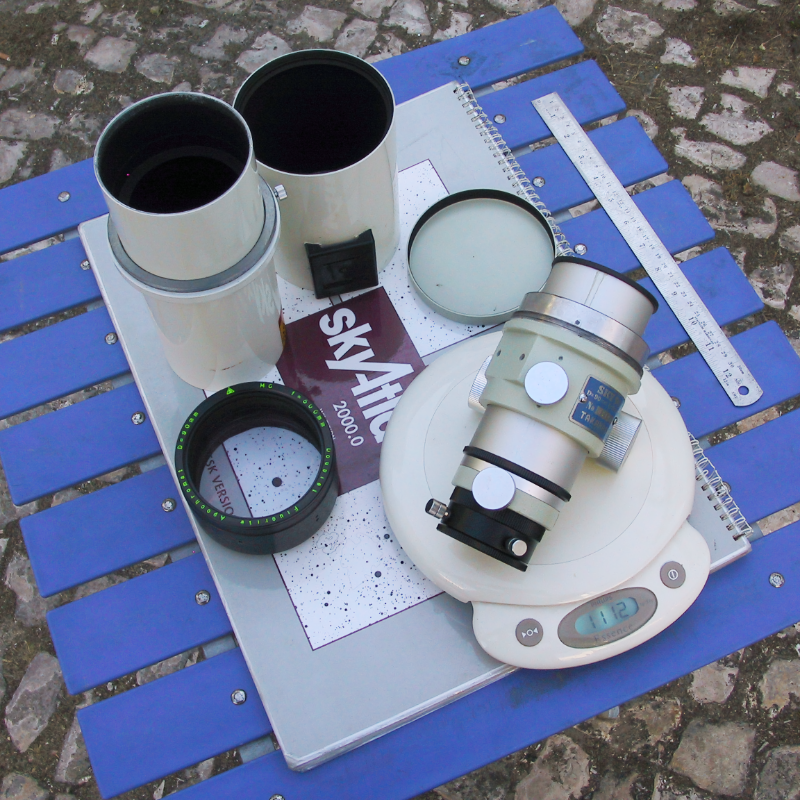

|
The Takahashi Sky-90 a apochromatic doublet refrator with an aperture 90mm and 500mm focal lenght.
The OTA it's like all the others Takahashi's refrators OTAs, aluminum constructed and painted on white mate color contrasting with green "pastel" focuser and chromed adjustment knobs. It's interior is totally finished on a non-reflective black. The focusing knobs are with aluminum on natural color.
The dewshield can be retracted along the tube,and it's interior is also covered with a non-reflective black rubber-like material, similar to felt but without "hair" that avoids the creation of particules that could affect the front lens. The dewshield advances about 80mm to the front of the objetive providing an efficient reduction of non-direct light parasites and also delays dew formation. it alsos come supplied with a aluminum objetive cover with felt lined edges. Inside the tube three baffles can be found. Looking through the tube it's absolutely black, with no reflexions whatever, and with no visible non-blackned sections.
A 50mm shorter version also exists, but seems to be only available in the North American market that allows more complex and longer optical trains.
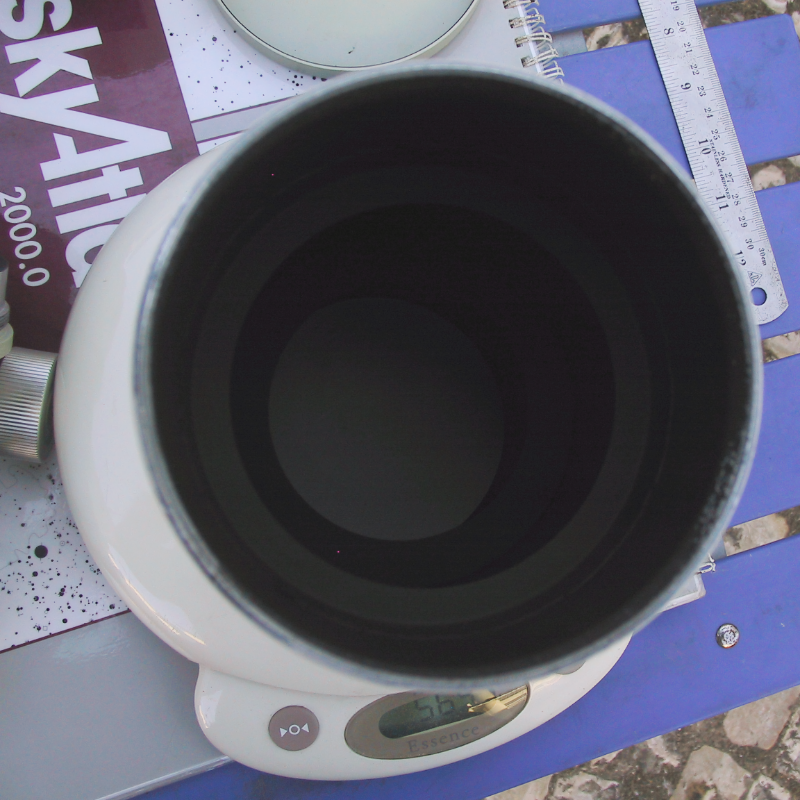
|
The focuser uses the Takahashi's traditional diagonal teeth rack and pinion system resulting on a precise and smooth movement without any play, being possible to adjust or securely lock it even when loaded with some pounds of equipment and accessories.
Although perfectly adequated for visual work and astrophotography, doesn't have the confort of a 10x reduction FeatherTouch-like focusers that allows (very) small focus corrections .This feature is especially convenient on the case of the astrophotography with short focal ratio optics due lower focus tolerances , or for very long focal configurations as in the case of high resolution planetary imaging.
Despite the focuser's solid construction with 5mm thick tube and a 70mm (2 3/4") diameter, the movement is still smooth and precise with any reasoneable load that you can screw at it, like should be expected from a quality astrophotographic focuser.
Although initially I had noticed some image shift while focusing, such behaviour stopped without apparent reason and without having touched on the adjustment screws, but probably with use, the grease spreaded better.
An optional (and expensive) accessory that I consider indispensable, is the Camera Angle Adjuster (CAA) that allows to rotate the camera or the diagonal line without the need to refocus. Although I consider it mandatory for astrophotography, this accessory should be "standard". The only inconvenience of having it permanently installed is not being able to completely insert the 2" star diagonal nose, about 7 milimeters are left out due adapter blockage, increasing this way the eyepiece distance to the focal plane, reducing or making impossible some eyepieces to reach focus, among others, the orthoscopics, monocentrics, Takahashi LEs and most 2" eyepieces types.
Finally, comes supplied with a 48mm (2") extension and a 1,25" adapter that allows to obtain focus with an eyepiece or camera without the need of a star diagonal , as usual with all the Takahashi refrator tubes. It may seem strange not to come with diagonal, surely very few users would use it this way visually, but I think to be part of the great system modularization and market strategy, of "not obligatory" to buy accessories that are not necessary, but thanks to this almost all the acessories and adapters can be shared with my small FC-60, and practically by all small/medium aperture Takahashi refrators.
The Takahashi telescopes all are part of same and unique photo/visual system, similar to the photographic systems like Canon, Nikon and other photographic systems - it has (well, almost) all the necessary accessories to implement whatever the configuration needed.
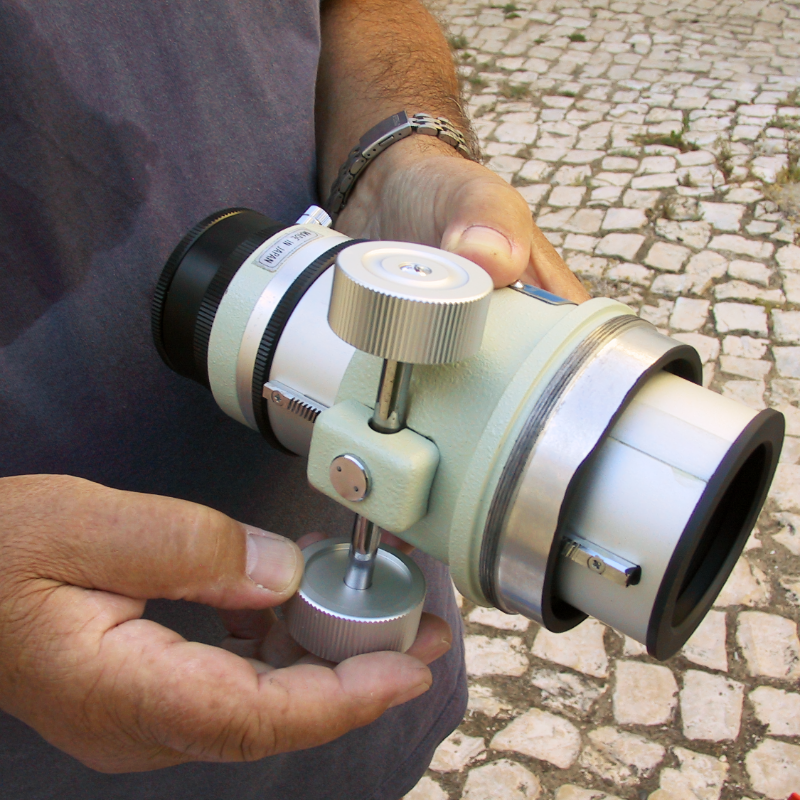 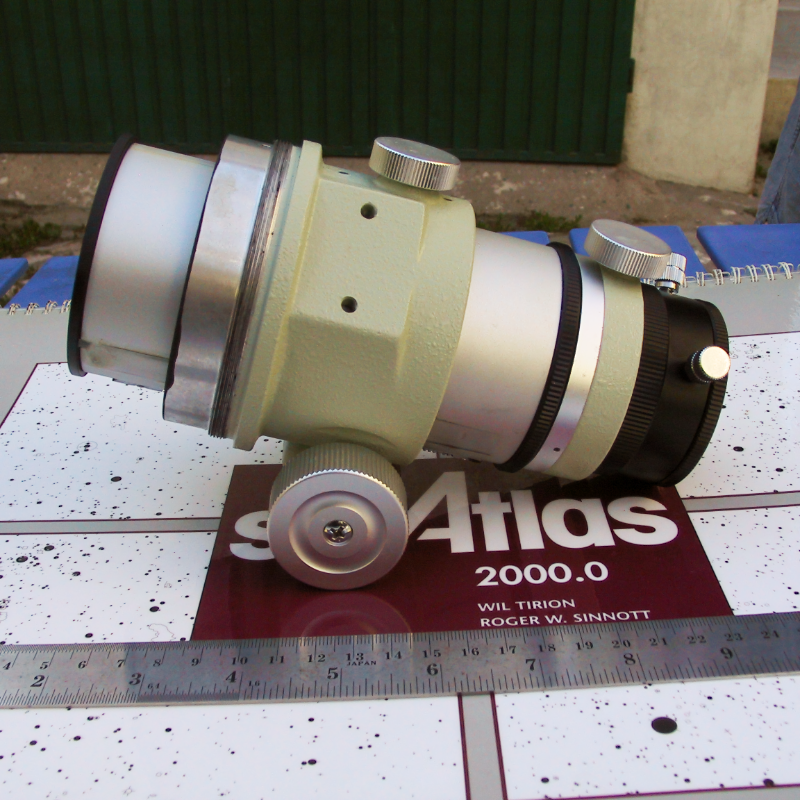
|
The objetive is constituted by a frontal fluorite (CaF2) biconvex positive element (crown) and a back negative plano-concave element (flint) of unspecified glass , forming an Fraunhofer doublet (curiously the FC-60 is a Steinheil doublet , or in other words, the elements had changed position, in this case to protect the uncoated fluorite element. Being a two elements objetive , it is theoretically impossible to obtain all the visible (and invisible) light wavelengths focused on the same plane with such a short focal ratio, but thanks to the fluorite it was possible to reduce the secondary spectrum to very low levels.
But the characteristic that really distinguishes this objetive from others is large distance between elements (13mm), instead of about 1mm or 2mm that is normally used on doublets. This characteristic raised some curiosity to try to understand the reason of this design. To learn more on this design see here and some interesting pages on doublets here.
In any in case that, a wide spacing between the elements provides an additional degree of freedom that allows to correct a good percentage of the spherical aberration and spherochromatism (spherical aberration in function of the wavelength), in part for if being able to apply less bending of the elements, also permiting some space for different element bendings. This design also needs a more robust cell and requires low tolerance assembly, resulting also on a lower tolerance to descolimation, already somewhat low at this focal ratio.
The objetive cell has uncommon weight and dimensions, weighing about 840 grams (30 oz) and it has nine screws: three main collimation screws and three more pairs that must be responsible to fix and mantain the distance between the elements.
The collimation can be executed by the user, what I consider a big plus, but the reverse of the medal is that you probably need to.
In the truth, the Sky-90 arrived to my hands badly descollimated, althought I didn't appreciated the fact then, it was a good opportunity to learn how to do it.
The first collimation should be made with the aid of the someone more experienced, this procedure to who never made it can be a bit intimidating. But as with everything, after the first collimations it becames a trivial operation, easily executed by only one person due the telescope short tube that allows to colimate without having that to take off the eye of the eyepiece. See here the Sky-90 collimation page (in french). A good collimation is important on short focus telescopes, it should be as accurate as possible.
Although the function of the 3 pairs of screws is to me unknown (but perhaps a consequence of the elements wide spacing) , these screws helped to fix a problem.
This specimen had rather notourious pinched optics (optics with improper pressure due materials dilatation or contraction) at ambient temperatures close to 273 degrees Kelvin (ok, 0 celsius), exibhiting slightly hexagonal difraction rings. These screws are factory sealed with glue, but after getting instructions from the european importer, I removed the glue and slightly alliviated 1/16 turn each one of the 3 pairs of screws, attenuating the problem to almost imperceptible levels. The hexagonal (aka Allen) collimation keys have an uncommon size - 1.5mm, being convenient to have at least three, one for each one of the screws.
Should point out that this type of problem affects most telescopes when under low temperatures. In the case of the Sky-90 the 3 pairs of screws were added to make possible solve the problem without having that to return it to factory. Those screw are essentially the difference from the "original" Sky-90. In U.S.A. the version with the extra screws is referenced by Sky-90II.
Sky_90 star-test didn't show any astigmatism , but the spherical aberration can vary between 1/2 and 1/8 wave subcorrection depending the optics stability in relation to the environment, generally about half an hour period. The value of 1/8 was only observed with the Extender-Q on a low turbulence and mild night. Typically the subcorrection oscillates between the 1/4 and 1/6 wave.
Some chromatism is present on the extra/intra focus difraction rings, and on focus on very bright white or blue stars, Some descolimation is enough to accentuate it more. On focus, the image is absolutely sharp on axis, only limited by difraction, showing a perfect airy disc with a faint first ring.
It is necessary to take in consideration that a visual star-test is quite sensitive to the atmospheric conditions, the instrument's stability and also the experience of the tester - in my case relatively low. These tests must only be considered as a "snapshot" of the conjunction of all those factors. Should not jump to hasty conclusions with only this test. Having had the chance to look through several certified high quality optics on several stability conditions , I give somewhat secondary value to this type of test on respect to the optical precision and smoothness, but nevertheless usefull to determine the existence of aberrations like astigmatism, improper pressure among others.
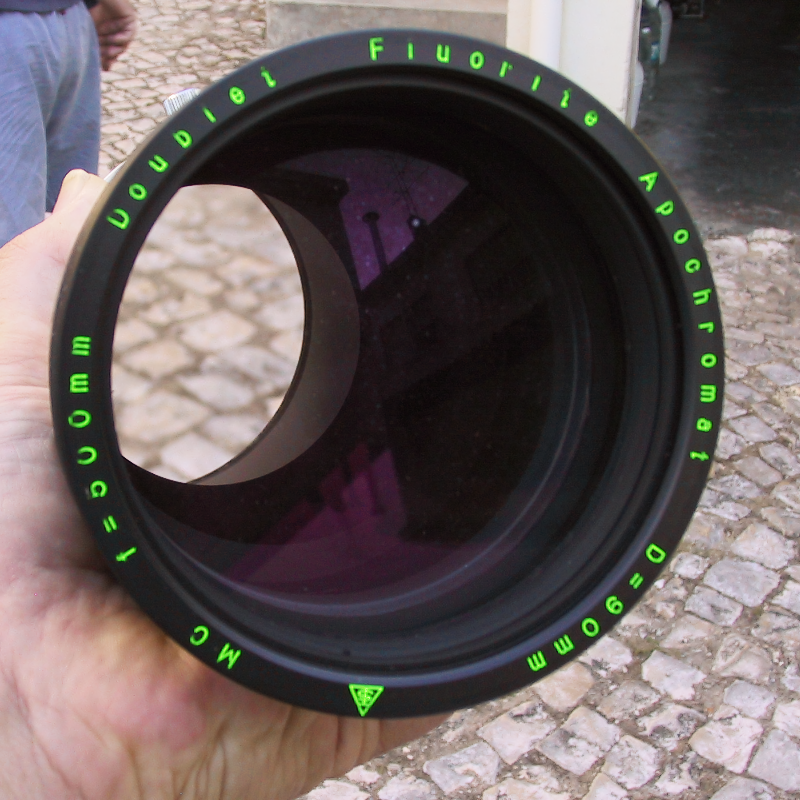 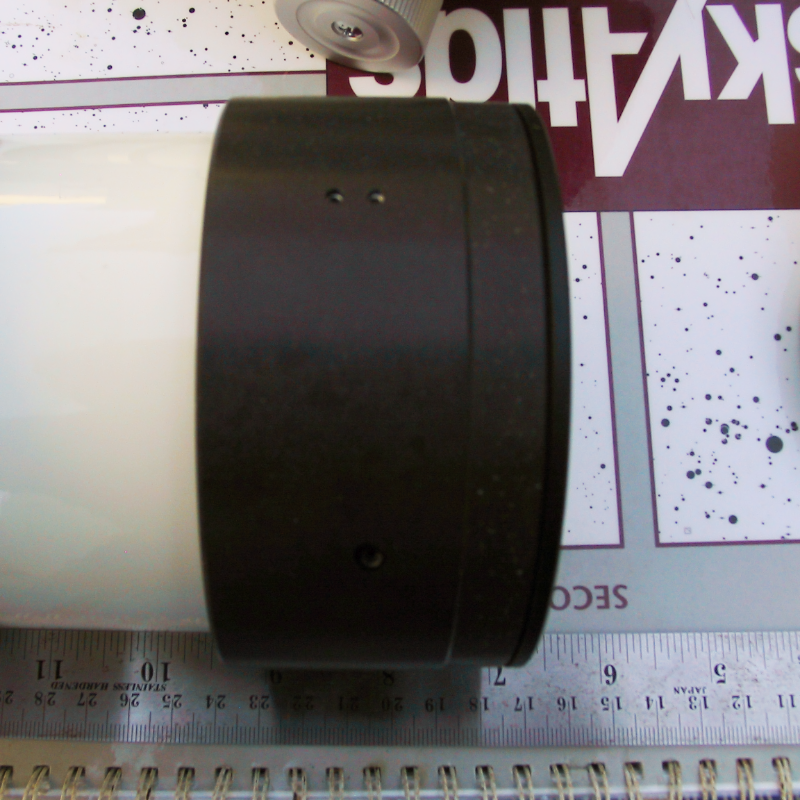
|
The Sky-90 with these accessories allows a great versatility, permiting a wide range of focal lengths that can go from f/3 to f/41 with corrected field, as long the sensor is not too big (above 1/2").
The dedicated reducer/flattener corrector is absolutely indispensable to get a flat field (sharp stars to the edge) on 35mm film or CCDs below of this size, giving a 45mm illuminated field and simultaneously putting the telescope working at f/4.5. A 407 mm focal length can not be considered high resolution, but is a good focal lenght for unguided wide-field astrophotography.
Using a Nikon D70 DSRL on the prime focus (with reducer) gives 4 degrees diagonal absolutely flat field , although some violet halos on the brighter stars can appear, but that varies with the exposure time.
The Extender-Q is another dedicated accessory not only for the Sky-90 but also the FSQ-106. According to manufacturer this extensor of 5 elements (some ED) was optimized to reduce the spherical sub-correction on the visible range that is typical of the Takahashi refrators, but also spherochromatism, especially on the UV region (to confirm). I can confirm that visually, a more perfect star test and with less chromatic aberration, and on CCD RGB imaging not having the need refocus with filter change. Unlike the reducer, this extensor does not correct the curved field, that will show up on bigger CCDs . This extender magnifies between 1.5x and 1.6x depending on the configuration.
Quite indispensable to not get back problems on visual work. This star diagonal is built like a russian submarine, it's collimable, and for all purposes "optically transparent".
This case is probably the most priority accessory, due Sky-90's appetence to descollimate on car trips due to (micro)vibrations. Nothing like a Pelican case to keep to all in safety and comfort. The model is the 1520 with enough spare space to take all the optical accessories, a finder , a little toolbox and even an eyepiece.
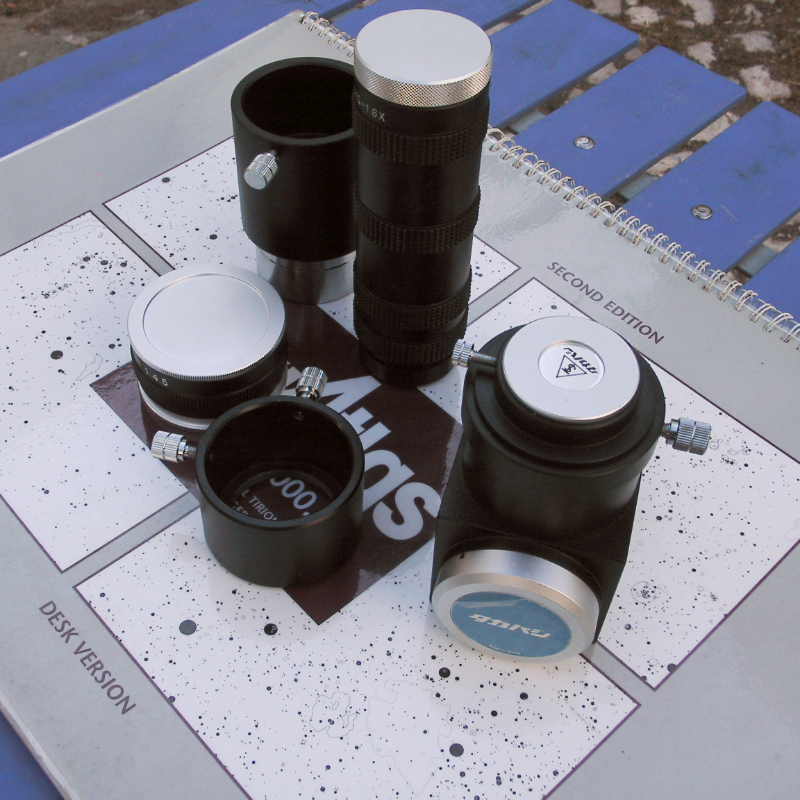 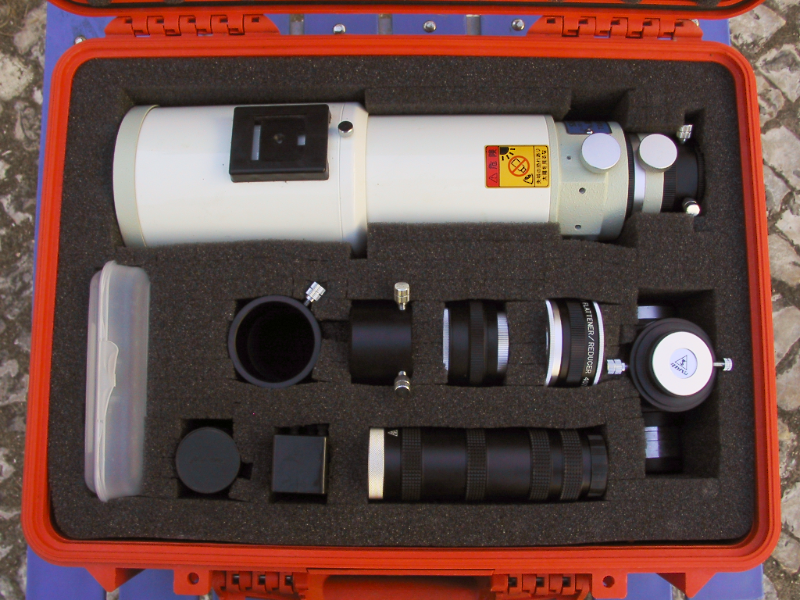
|
At visual use I consider the Sky-90 excellent. It has an excellent contrast, easily available theoretical resolution, supporting magnifications well above 2x by milimeter, basically limited by light grasp and/or submilimetrical exit pupils. The color correction is excellent except on the very bright white or blue stars that can show a small traces of purple/violet . On the planets it is necessary to really want to see something wrong, or when the atmospheric dispersion play some tricks.
When I write the ugly words like "chromatic aberration", by no means can be compared with what is observed on semi-apos or achromats doublets with the same focal ratio. A coleague funnly observed that is more like a "apochromatic aberration".
After almost one year of use, I can conclude that visually, the chromatic aberration is as intrusive as on it cousins of the FC/FS series which are native f/8 telescopes , what in my point of view it is no far behind of being an impressive performance for a telescope with such low focal ratio.
A down issue is that not all the eyepiece combinations will result on a corrected field, not exactly eyepieces fault , but the telescope's wide light cone. The Televue 31mm and 12mm Naglers practically have a perfect corrected field, closely followed by the Panoptic 24mm. On the Radians and type 6 Naglers as well on the Zoom 3-6 mm, the last third already shows some astigmatism/coma. On plossl and orthoscopics (but not all) are practically only corrected on 50% of the central area . It cannot be considered a very tolerant telescope in respect to the eyepieces.
I use to perform a good sky survey with every telescope that I acquire, and this telescope was not exception. It already provided many and excelent wide fields views of nebulas, cluster and galaxies, also having a good depth (ie: quasar 3c273), having exceeded my expectations on contrast and transparency that I consider between the best ones that I have experience.
It is a true pleasure to observe double stars and bright clusters through this telescope, especially with the Extender-Q wich transforms it into a high resolution visual telescope, exceeding easily 3x by millimeter magnifications without any lost on sharpness, also giving interesting images of the giant planets.
But 90mm is still only 90mm, therefore an limited number of immediately accessible objects, but on the other hand it becomes the challenges quite more interesting.
At f/4.5 focal ratio with the corrector/reducer turns it on a telescope of great photographic speed. These focal ratios allow to get images with a relatively short exposure time, avoiding on some cases auto-guiding to achieve images that can be considered decent. Despite short focal having lower focusing tolerances I do not find particularly difficult to focus it manually.
The secondary spectrum is quite more intrusive than on visual work, quite noticiable on RGB images containing bright white stars, typically magnitude 5 stars and brighter in the case of atik 1hs CCD . The effect is a famous violet halo that if can be seen in these images of known stars, notourious in the case of the Nu Draconis, but I suspect that Nikon D70 CCD filter exarcebates the effect a bit. Although on some photographic compositions containing bright class A, O or B stars can be really unaesthetic, I find it an acceptable trade-off . Excepting on the blue/UV region , the telescope seems to be well corrected all the way into the infrared.
Coupled with the extender-Q is more worthier of the apochromat name, with the chromatism is almost absent and with a slightly better corrected spherical aberration . In practice this results not having to refocus when switching to the blue filter, but it loses photographic speed working at f/7.
The images below show 3 equal time exposures using Astronomik RGB filters . It was made an effort to get the best focus for each one of the filters, having the blue filter required some adjustment, not being parafocal in this focal relation (f/4.5).
The star at Zeta Leonis eleven hours (the brighter one) has a G2 spectrum class - same as our Sun that is the definition of white star on our diurnal vision. It didn't make any atmospheric extintion adjustment, except imaging while at the area around the local meridian, or had in account the CCD spectral sensitivity that probably it is less sensible on the blue region.
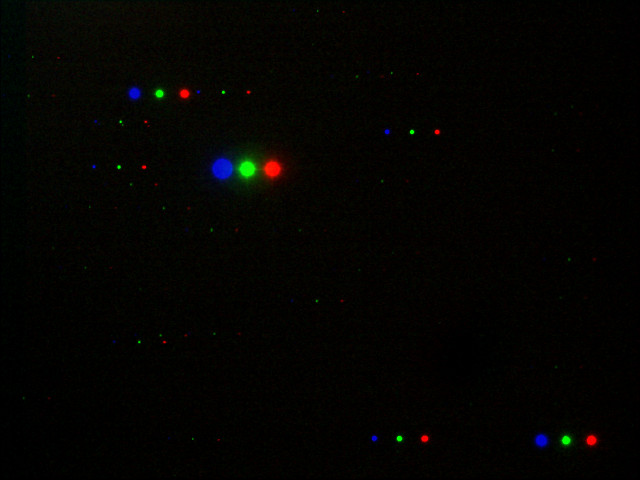 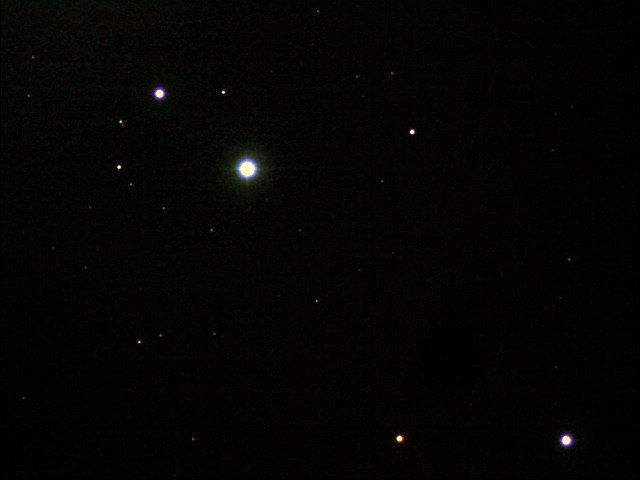
|
|
Adhafera - Zeta Leonis e a G2V
Takahashi Sky-90 f/4.5 (407mm) + ATIK-1HS 2.9" res 60%
exp: 9 min. (3*180 seg.) RGB (Astronomik 2c) |
While not perfect, the obtained chromatic correction with only 2 elements is quite remarkable.
The table below summarizes several focal lengths configurations that can be used with the corrected field and here can be seen some flatness tests with a small/medium CCD (Nikon D70):
At the prime focus without flattener less than 25% of the image area is acceptable (700 pixels square) that corresponds to a bit more than 5mm maximum size CCD. On the other hand with the flattener the full size of nikon's D70 sensor, 23.7mm, is fully corrected.
| Sky-90+adapter | focal length |
| redutor Takahashi f/4.5 (Sky-90) + Atik redu | 270 mm (f/3.0)(1) |
| redutor Takahashi f/4.0 (FC-60) | 360 mm (f/4.0)(1,2) |
| redutor Takahashi f/4.5 (Sky-90) | 407 mm (f/4.5)(1,2) |
| Native f/5.6 | 500 mm (f/5.6)(1,2w |
| Extender-Q | 640 mm (f/7.1)(1,2) |
| Extender-Q + Powermate 2.5x | 2750 mm (f/30)(1) |
| Extender-Q + Powermate 5x | 3720 mm (f/41)(1) |
(1) - Atik 1HS/2HS(2) Nikon D70
To do true justice with what that can be obtained with this telescope as astrograph, I do not really advise my Patio , just search the web to find real masterpieces, but below I leave some of the my efforts.
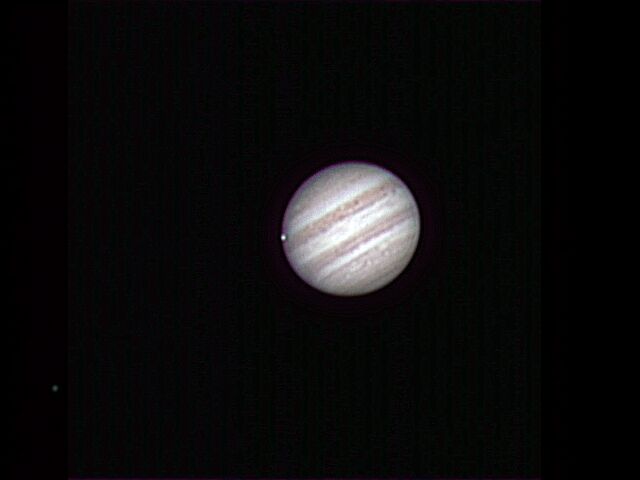 Takahashi Sky-90 f/41 (3720mm) + Toucam 0.31" |
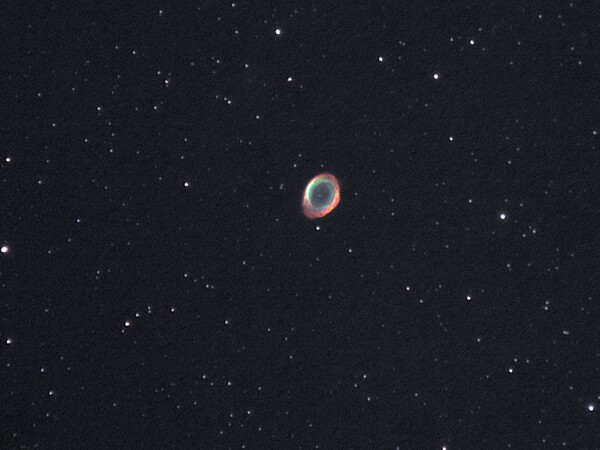 Messier 57, NGC 6720, PK 63+13.1
Takahashi Sky-90 f/7 (640mm) + ATIK-1HS 1.81"
exp: ha-lrgb (60x60)+(4x36x20) seg. mag. 4 |
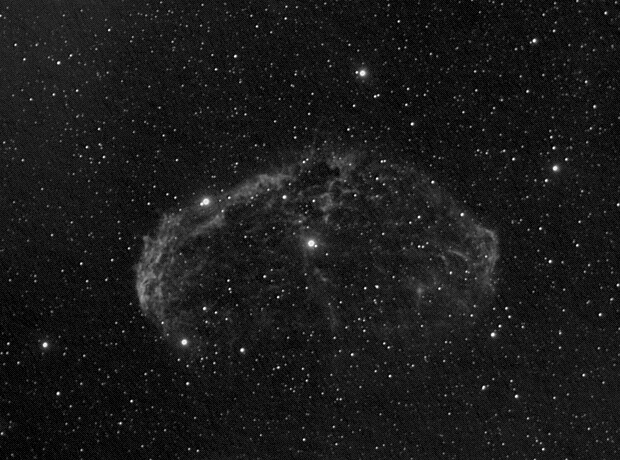 NGC 6888, "Nebulosa Crescente"
Takahashi Sky-90 f/4.5 (407mm) + ATIK-1HS 2.9" 60% h-alpha
exp: 120 min. (60x120 seg.) mag. 5 |
this is time in just one piece.
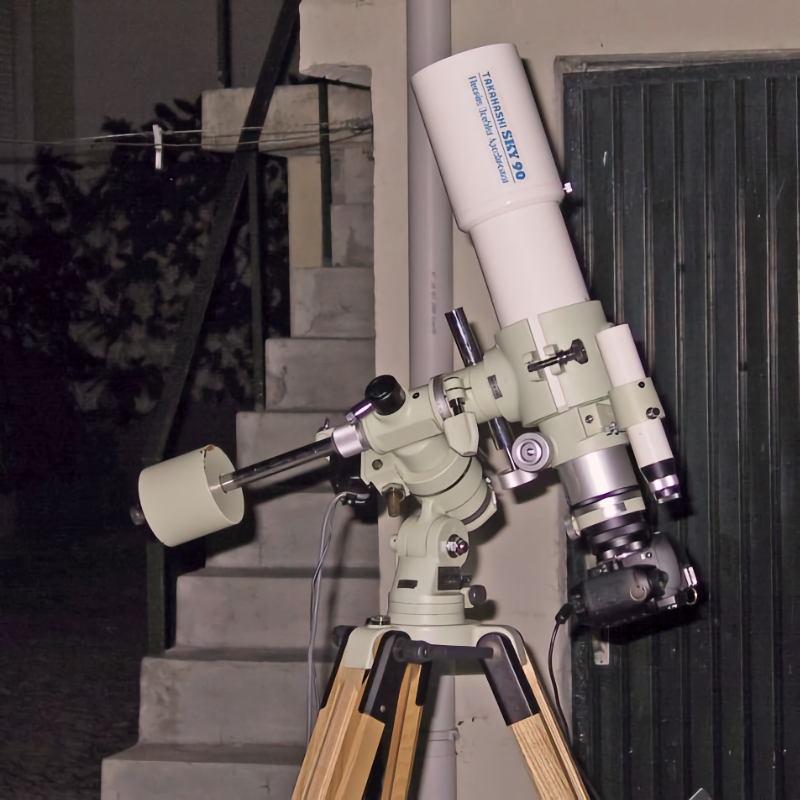 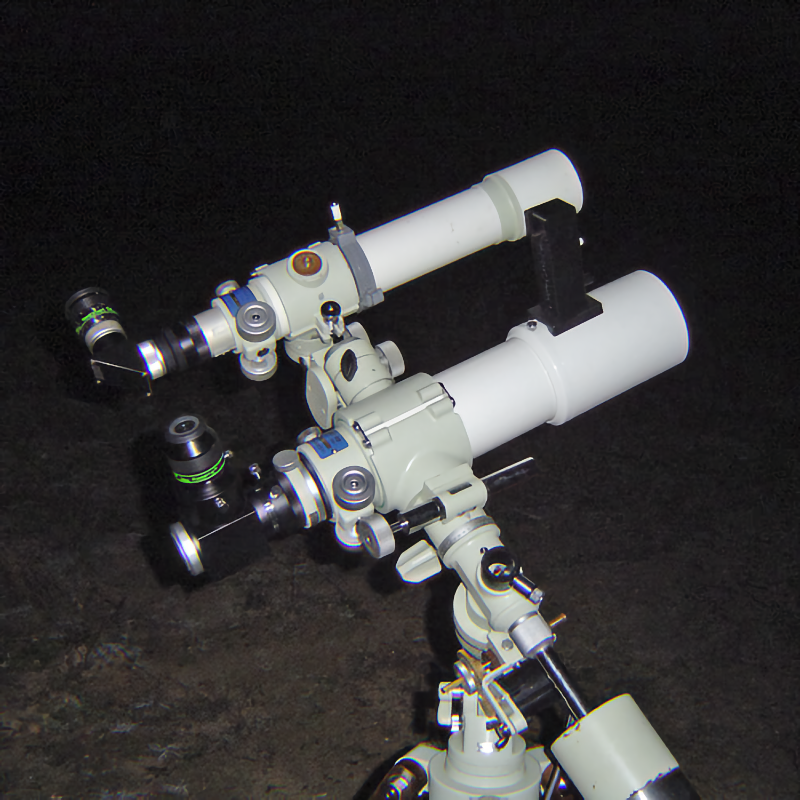 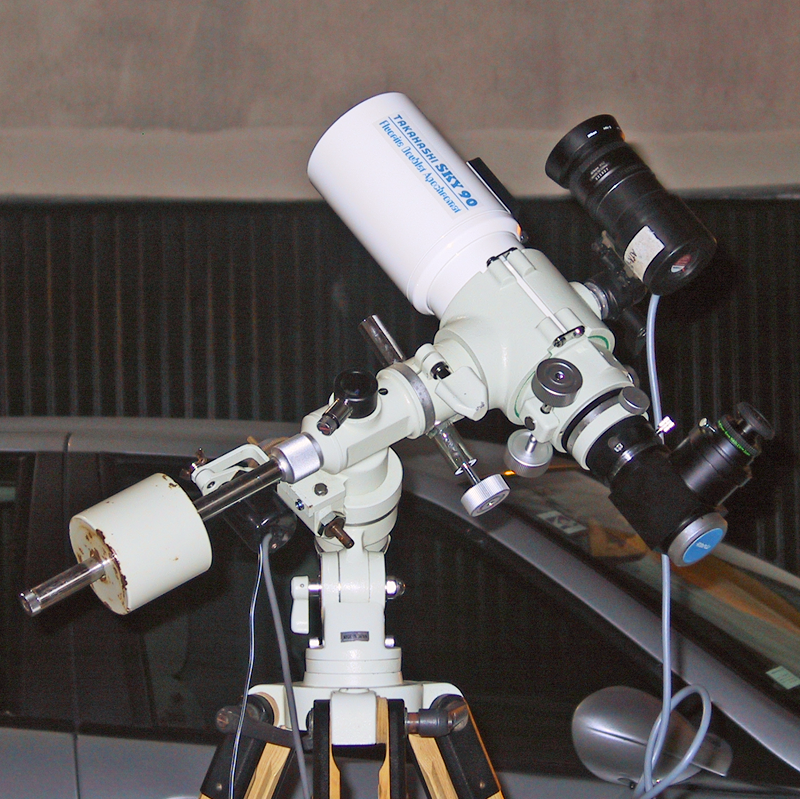
|
The Sky-90 isn't a perfect telescope, but can be considered an apochromatic fluorite doublet of great quality.
It's incredible compact and light, mechanically excellent, the optics by design won't reach the level of chromatic correction of good triplet, but it is largely compensated by a amazing contrast and a more than satisfactory optical performance.
Luís Carreira, September 2005